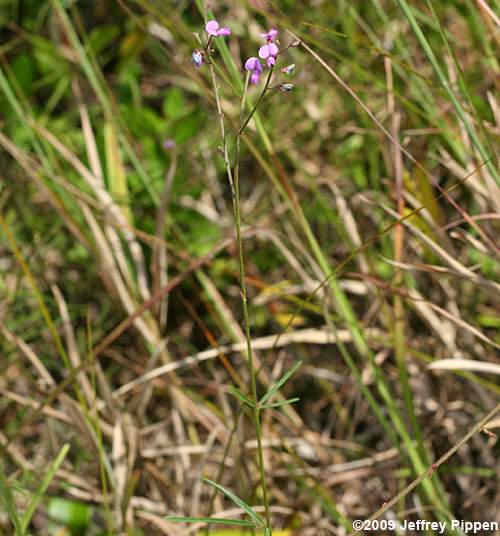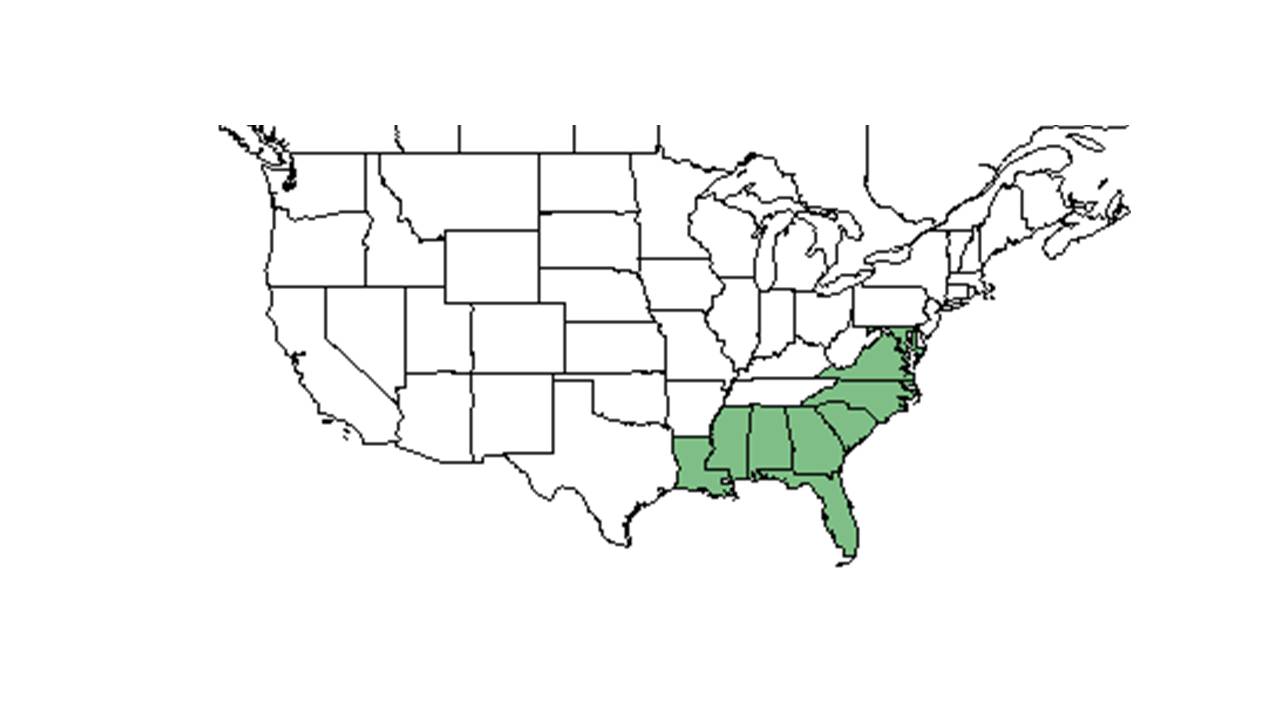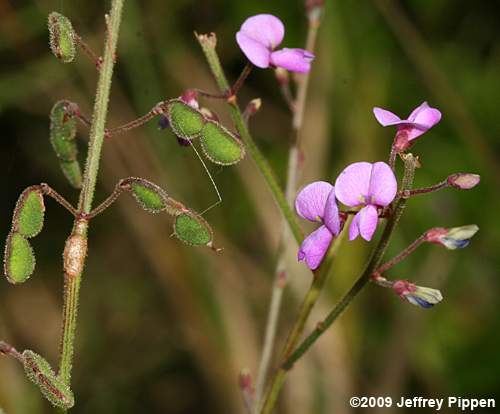Desmodium tenuifolium
| Desmodium tenuifolium | |
|---|---|

| |
| Photo taken and permission granted by Jeff Pippen, JeffPippen.com | |
| Scientific classification | |
| Kingdom: | Plantae |
| Division: | Magnoliophyta - Flowering plants |
| Class: | Magnoliopsida – Dicotyledons |
| Order: | Fabales |
| Family: | Fabaceae ⁄ Leguminosae |
| Genus: | Desmodium |
| Species: | D. tenuifolium |
| Binomial name | |
| Desmodium tenuifolium Torr. & A. Gray | |

| |
| Natural range of Desmodium tenuifolium from USDA NRCS Plants Database. | |
Common name: slimleaf tick-trefoil
Contents
Taxonomic notes
Synonym: Meibomia tenuifolia (Torrey & A. Gray) Kuntze[1]
Varieties: none[1]
Description
Generally, for Desmodium genus, they are "annual or perennial herbs, shrubs or small trees. Leaves 1-5 foliolate, pinnately 3-foliolate in ours or rarely the uppermost or lowermost 1-foliolate; leaflets entire, usually stipellate; stipules caduceus to persistent, ovate to subulate, foliaceous to setaceous, often striate. Inflorescence terminal and from the upper axils, paniculate or occasionally racemose; pedicel of each papilionaceous flower subtended by a secondary bract or bractlet, the cluster of 1-few flowers subtended by a primary bract. Calyx slightly to conspicuously 2-lipped, the upper lip scarcely bifid, the lower lip 3-dentate; petals pink, roseate, purple, bluish or white; stamens monadelphous or more commonly diadelphous and then 9 and 1. Legume a stipitate loment, the segments 2-many or rarely solitary, usually flattened and densely uncinated-pubescent, separating into 1-seeded, indehiscent segments." [2]
Specifically, for D. tenuifolium species, they are "erect, perennial herb; stems 0.5-1.2 m tall, densely but inconspicuously uncinulate-puberulent and sparsely uncinlate-pubescent, often becoming glabrate below. Terminal leaflets very narrowly linear, often 8-15 X as long as wide (2.5) 4-8 cm long, 3-8 mm wide, glabrous to minutely puberulent above, sparsely short-pubescent beneath, especially along the veins, noticeable reticulate; stipules linear to linear-subulate, 2-5 mm long; stipels persistent. Inflorescence usually paniculate; pedicels 4-10 mm long. Calyx densely puberulent and sparsely short-pubescent; petals pinkish to purplish, 4-5 mm long; stamens diadelphous. Loment of 1-3 suborbicular to subelliptic segments, each 3.5-5 mm long, 2.5-3.5 mm broad, upper suture of each segment bowing outward, uncinulate-puberulent on both sides and sutures; stipe 1-2 mm long, slightly shorter to barely exceeding the calyx and shorter than the stamina remnants." [2]
Distribution
D. tenuifolium is native to the southeast United States from southeast Virginia down to central peninsular Florida and west to western Louisiana.[3] It is an endemic of the southeast coastal plain[4] longleaf pine forest range.[5]
Ecology
Habitat
Generally, D. tenuifolium can be found in wet pine flatwoods and savannas.[3] This species has been observed in wiregrass savannas, mesic woodlands, flatwoods, pond margins, and longleaf pine forests. It also occurs in disturbed areas such as roadsides and clear-cuts.[6] It generally prefers semi-shaded habitats with dry to moist sandy soils, including loamy sand, sand, and sandy peat. [6] In North Carolina D. tenuifolium is found in mesic and dry type pine savanna maintained with frequent fire. Mesic savannas in North Carolina consist exclusively of Pinus palustris. Dry savannas in North Carolina typically occur on the high, central portion of the more dome-shaped islands, or where the soil is coarse textured and well drained.[7] It is found in mesic habitats, but not in areas where water stands for any length of time. It can also commonly be found in ecotones between uplands and wet streamheads or bayheads, and ecotones between savannas or flatwoods and pocosins.[8] In Florida, it is an indicator species of the upper panhandle savanna communities.[9]
Associated species include wiregrass, slash pine, saw palmetto, longleaf pine. [6]
Desmodium tenuifolium is an indicator species for the Upper Panhandle Savannas community type as described in Carr et al. (2010).[10]
Phenology
D. tenuifolium generally flowers from July to August and fruits from August to October.[3] Flowering has been observed in May, September and October, with peak inflorescence in September and fruiting has been observed in July, September, October, and November.[11][6]
Fire ecology
This species is found in savannas that are frequently burned.[7] With fire exclusion, D. tenuifolium tends to disappear.[12]
Herbivory and toxicology
There is only one record where the seeds of Desmodium tenuifolium were found in a bobwhite quail's stomach. [13]
Conservation, cultivation, and restoration
In areas where fire management is not possible, like powerlines, mowing or spraying (for woody plants) can help stimulate the effects of fire on the community.[8]
Cultural use
Photo Gallery
Flowers & seed of Desmodium tenuifolium Photo/permission by Jeff Pippen, JeffPippen.com
References and notes
- ↑ 1.0 1.1 Weakley, A.S. 2020. Flora of the Southeastern United States. Edition of 20 October 2020. University of North Carolina at Chapel Hill, Chapel Hill, North Carolina.
- ↑ 2.0 2.1 Radford, Albert E., Harry E. Ahles, and C. Ritchie Bell. Manual of the Vascular Flora of the Carolinas. 1964, 1968. The University of North Carolina Press. 604-8. Print.
- ↑ 3.0 3.1 3.2 Weakley, A. S. (2015). Flora of the Southern and Mid-Atlantic States. Chapel Hill, NC, University of North Carolina Herbarium.
- ↑ Sorrie, B. A. and A. S. Weakley (2001). "Coastal plain vascular plant endemics: Phytogeographic Patterns." Castanea 66(1/2): 50-82.
- ↑ Sorrie, B. A. and A. S. Weakley 2001. Coastal Plain valcular plant endemics: Phytogeographic patterns. Castanea 66: 50-82.
- ↑ 6.0 6.1 6.2 6.3 Florida State University Robert K. Godfrey Herbarium database. URL: http://herbarium.bio.fsu.edu. Last accessed: June 2014. Collectors: Loran C. Anderson, J.P. Gillespie, R.K. Godfrey, R. Komarek, R. Kral, Robert L. Lazor, S.W. Leonard, and John Morrill. States and Counties: Florida: Bay, Franklin, Jefferson, Liberty, Madison, and Wakulla. Georgia: Baker, Decatur, and Thomas. North Carolina: Harnett. Alabama: Covington.
- ↑ 7.0 7.1 Walker, J. a. R. K. P. (1984). "Composition and Species Diversity of Pine-Wiregrass Savannas of the Green Swamp, North Carolina." Vegetatio 55(3): 163-179.
- ↑ 8.0 8.1 [[1]] NatureServe Explorer. Accessed: April 26, 2019
- ↑ Carr, S. C., et al. (2010). "A Vegetation Classification of Fire-Dependent Pinelands of Florida." Castanea 75(2): 153-189.
- ↑ Carr, S.C., K.M. Robertson, and R.K. Peet. 2010. A vegetation classification of fire-dependent pinelands of Florida. Castanea 75:153-189.
- ↑ Nelson, G. PanFlora: Plant data for the eastern United States with emphasis on the Southeastern Coastal Plains, Florida, and the Florida Panhandle. www.gilnelson.com/PanFlora/ Accessed: 26 APR 2019
- ↑ Hendricks, J. J. and L. R. Boring (1999). "N2-fixation by native herbaceous legumes in burned pine ecosystems of the southeastern United States." Forest Ecology and Management 113(2–3): 167-177.
- ↑ [Edward Graham Google Books] Graham, Edward II. (1941). Legumes for erosion control and wildlife. U.S. Department of Agriculture. Accessed: April 22, 2016.
